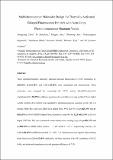Multichromophore molecular design for efficient thermally activated delayed-fluorescence emitters with near-unity photoluminescence quantum yields
Abstract
Three multichromophore thermally activated delayed fluorescence (TADF) molecules, p-di2CzPN, m-di2CzPN, and 1,3,5-tri2CzPN, were synthesized and characterized. These molecules were designed by connecting the TADF moiety 4,5-di(9H-carbazol-9- yl)phthalonitrile (2CzPN) to different positions of a central benzene ring scaffold. Three highly soluble emitters all exhibited near quantitative photoluminescence quantum yields (ΦPL) in toluene. High ΦPLs were also achieved in doped films, 59% and 70% for p-di2CzPN and m-di2CzPN in 10 wt% DPEPO doped films, respectively, and 54% for 1,3,5-tri2CzPN in 20 wt% doped CBP film. The rate constant of reverse intersystem crossing (kRISC) for p-di2CzPN and m-di2CzPN in DPEPO films reached 1.1×105 and 0.7×105 s−1, respectively, and kRISC for 1,3,5-tri2CzPN in CBP film reached 1.7×105 s−1. A solution-processed organic light-emitting diode based on 1,3,5-tri2CzPN exhibited a sky-blue emission with CIE coordinate of (0.22, 0.44), and achieved a maximum external quantum efficiency of 7.1%.
Citation
Chen , D , Kusakabe , Y , Ren , Y , Sun , D , Rajamalli , P , Wada , Y , Suzuki , K , Kaji , H & Zysman-Colman , E 2021 , ' Multichromophore molecular design for efficient thermally activated delayed-fluorescence emitters with near-unity photoluminescence quantum yields ' , The Journal of Organic Chemistry , vol. Articles ASAP . https://doi.org/10.1021/acs.joc.1c01101
Publication
The Journal of Organic Chemistry
Status
Peer reviewed
ISSN
0022-3263Type
Journal article
Description
D.C thanks the China Scholarship Council (201603780001). P. R acknowledges support from a Marie Skłodowska-Curie Individual Fellowship (No. 749557). D. S. acknowledges support from the Marie Skłodowska-Curie Individual Fellowship (No. 838009). We acknowledge support from the Engineering and Physical Sciences Research Council of the United Kingdom (grant EP/P010482/1), from the International Collaborative Research Program of Institute for Chemical Research, Kyoto University (Nos. 2020-37 and 2021-37), and from JSPS KAKENHI Grant Number JP20H05840 (Grant-in-Aid for Transformative Research Areas, “Dynamic Exciton”).Collections
Items in the St Andrews Research Repository are protected by copyright, with all rights reserved, unless otherwise indicated.

